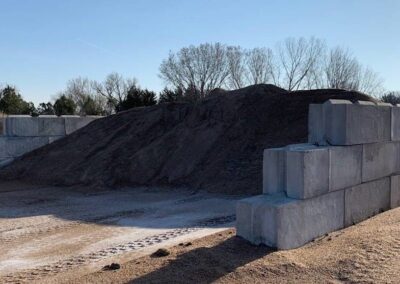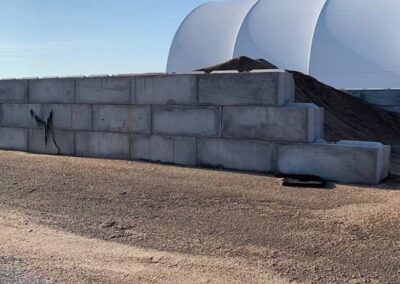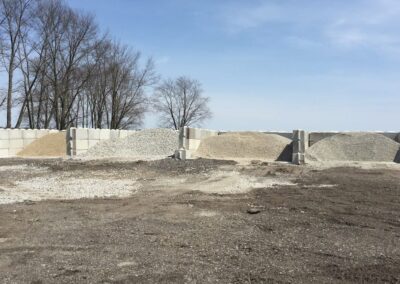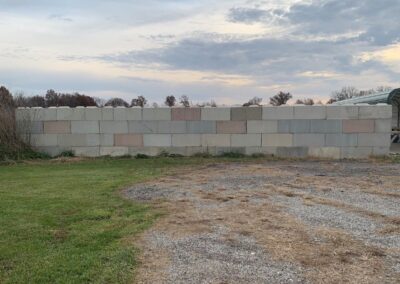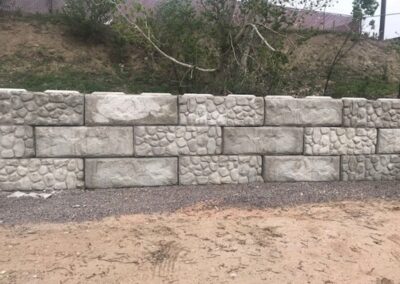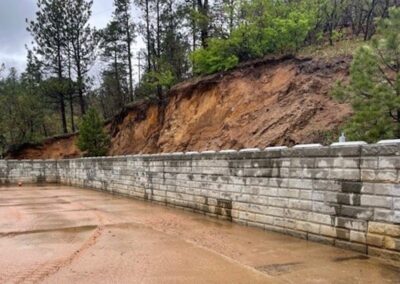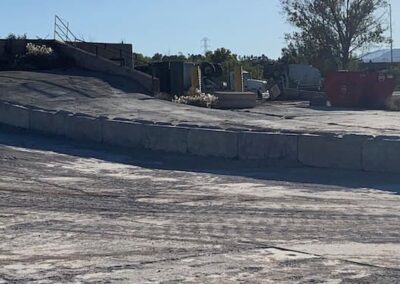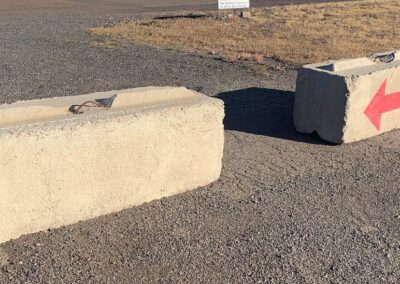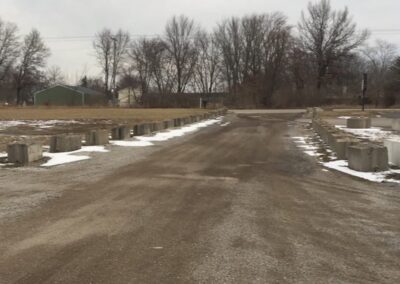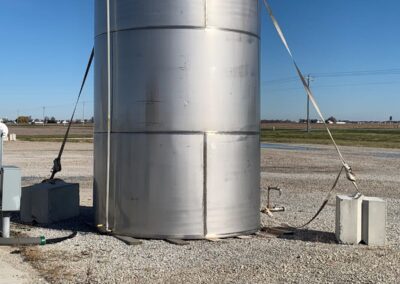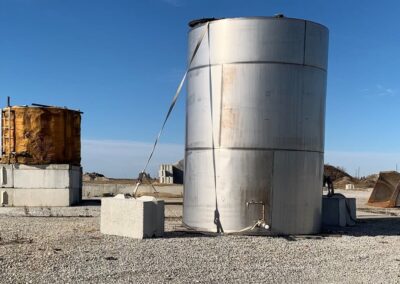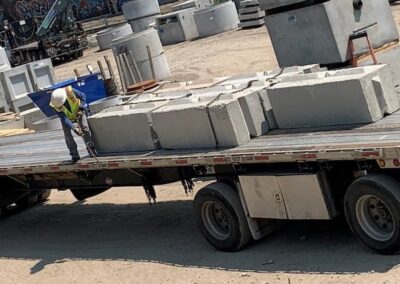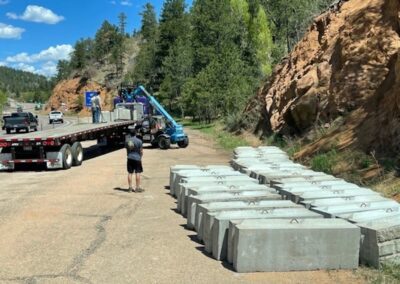Everything You Wanted to Know About Concrete Blocks
Get Your Free Quote Today
The kind of concrete blocks we are going to discuss here are larger concrete blocks. These are not your run-of-the-mill cement blocks, nor H-blocks like you can find at any nearby home improvement store. These large concrete blocks are quite special compared to that of common concrete blocks used for everyday projects. These are 1,800 lbs to 8,100 lbs large concrete blocks that require particular machinery and equipment to move them around and assemble them. Are you interested in knowing more? Please keep reading and we will try to tell you everything you ever wanted to know about concrete blocks.
How are concrete barrier blocks made?
Concrete barrier blocks are produced with special steel forms made by a few manufactures, most notably by World Block & Benton Block. I’m sure there are others, but those are the two I’m most familiar with. World Block manufactures two different types of block forms that we used blocks from. The most common block model throughout the US is the V-Interlock form. (We generally refer to it as the V-Wedge) They come in a few varying dimensions, including: a 6’L x 2’W x 2’H (straight & corners), a 5’L x 2’W x 2’H corners, a 4’L x 2’W x 2’H straight, a 3’L x 2’W x 2’H straight, and a 2’L x 2’W x 2’H straight. All of these blocks have a V shape that extends out along the top of the block and one side of the block. In addition, the bottom and opposite side have a V shaped indentation, allowing the blocks to fit together, which can be useful in a variety of projects. A problem that can come up with these blocks along with the purchasing process, is that all of these lengths and shapes are not available in all areas. The costs to own and track all the different sizes of shapes and forms is not something most manufactures are willing to do. So, you typically end up with one or two sizes of the blocks with straights and no corners. Another variant and style that World Block also produces is what they call the Knob Style. These forms produce concrete blocks that are 60”L x 30”W x 30”H and 30”L x 30”W x 30”H. Here at Concrete Block Supply, We call them “Lego Blocks” and change the dimensions into feet, so we typically would refer to them as 5’L x 2.5’W x 2.5’H and 2.5’L x 2.5’W x 2.5’H. A nice feature with this style and size of block is that you can make a corner with the standard block; therefore you do not have to have a special corner block to make a corner shape. Another unique and cool feature with these particular blocks is that World Block does produce a few different liners that can be laid down inside of the forms to create blocks with a decorative façade on one side. They offer: a cut stone, a random rock, a river rock, a river stone, a rock face, etc. The company Benton Block produces forms that make the same two dimension of barrier blocks that World Block makes: 6’L x 2’W x 2’H and 5’L x 2.5’W x 2.5’H, each one of the sizes can be made into concrete blocks that are shorter in length by adding a divider into the form. The Benton Blocks interlocking style is actually very nice. Each of these concrete blocks are equipped with 8 to 12 lego or castle protrusions on the top and the opposite on the bottom of the block. These help interlock the block side to side and length wise. It also allows these blocks to be used as corners or as a T shape, if desired. This single style of concrete block can be used in a multitude of wall building configurations, but it is currently not widely distributed throughout the US. Regardless of the steel form manufacturer, these concrete blocks are poured in a similar manner. In this process, the steel form being used is assembled in its final shape. A rebar handle is then set into the steel form, which later is used as a lifting point for the concrete barrier blocks. A concrete truck will then fill the form with the concrete mixture and then concrete hardens in as little as a few hours; it really all just depends on the concrete mix itself.The steel form is then broken down and then pulled away from the concrete block, which then allows the drying concrete to continue to cure. These concrete blocks are then typically stacked together into storage piles the following day, as they continue to set and dry completely. The form then can be reassembled in another spot, which allows it to be filled with a concrete mixture again. Typically, the concrete used to fill the forms is made from a variety of excess concrete pieces from some different job sites.This concrete can range in mix design, in PSI, and even in color, which does lead to some alterations in the final look of the concrete blocks that are produced. A generally accepted minimum of a concrete block PSI is 3000. Instead of getting rid of the excess concrete pieces and then continuing to pay to recycle the concrete waste, the extra concrete is especially used to create these particular blocks. This also helps allow the concrete blocks to generally be sold at quite a cheaper price compared to that of a yard of raw concrete. Something to especially note is that by using excess concrete pieces, the PSI and coloration of the concrete can vary from each concrete block to each concrete block. When you choose to buy these special concrete barrier blocks you can thankfully pat yourself on the back for doing your part in choosing to use recycled materials and be a thrifty spender in the world of concrete blocks and business.
What are these concrete blocks called? How did they get their names?
Now, we can discuss the different, unique concrete block names that these special, large concrete blocks go by. I will then try and explain to the best of my knowledge, how they got their particular names. We can start with what I believe is the most common name for the concrete blocks and then we can continue to work our way down the list of all the different concrete block names that are often used when it comes to concrete block referral. There are so many different names and the possibilities for new names to be added are endless. If you have any other concrete block names that you know of, please feel free to contact us and we can chat!
Bin Blocks:
The name “bin blocks” is simply derived by a common use of these concrete blocks, which is to create a classic storage bin for materials. You can use these blocks to construct their signature storage bin shapes, which can be built in all different shapes, sizes and can be used for quite a numerous amount of things.
Concrete Barrier Blocks:
This concrete block name, again, is derived from a common use of concrete blocks, which is to form a barrier to protect an object or property. To be more specific, they can protect certain utilities, propane tanks, and fuel tanks. They also can be used to separate or close off certain areas of property.
Mafia Blocks:
The best that I can determine is this concrete block name comes from the New York and New Jersey area. This area is where the mafia used to control a majority of the concrete production. This just so happened to create the term mafia block. Personally, I think it is more like “concrete shoes’ ‘, a body could easily fit into the form and then be filled with concrete, creating a “mafia block” which would forever hide their deeds.
Ecology Blocks:
This concrete block name is actually based on the production methods of these concrete blocks. Excess concrete is used to fill the concrete block forms, creating the ecology concrete blocks instead of just dumping it and letting it go to waste, thus recycling the concrete.
Bunker Block:
I can only assume that this concrete block name comes from the use of the blocks. However, as far as my knowledge goes, I’ve never had anyone create a bunker out of these concrete blocks. Who knows? There might actually be someone out there who has had the idea to do so.
Interlocking Concrete V-Blocks:
This concrete block name is simply from the interconnecting feature of a style of blocks. These blocks come with both a particular, signature v shaped wedge on the top and side and the same wedge, but reversed, on the bottom and opposite side. They can be used for a variety of projects and their ability to interlock easily, comes in handy. The possibilities of these blocks are endless.
Lego Blocks:
This name, “lego blocks” also simply comes from the special interconnecting feature of a style of blocks. They look just like their name states: like the fun, interlocking toy bricks most of us played with as kids.
Knob Blocks:
This concrete block name is also simply from the interconnecting feature of a style of blocks. These blocks do look a tad bit similar to the lego concrete block style.
Large Retaining Wall Blocks:
This concrete block name comes from the size and use of the concrete blocks and not having a universally known name. So, generally, we just refer to them as large retaining wall blocks.
Waste Blocks:
This is similar to the concrete block name “ecology blocks” and stems from excess, job site, waste concrete pieces being used to create the blocks. Again, this process of concrete recycling cuts concrete block prices way, way down and enables the purchase of these recycled concrete blocks to become much easier and efficient.
Gravity Wall Blocks:
This concrete block name is also derived from the particular use of these concrete blocks. Due to the size and weight of these concrete blocks, the retaining wall they create is referred to as a “gravity wall”. The force of the gravity on these particular concrete blocks is greater than the force of whatever these blocks are positioned to hold back.
What are some uses of ecology blocks?
While Ecology blocks have quite the multitude of uses, there are usually five main uses that seem to rank above the rest. Those uses include the creation of concrete, material, storage bins, concrete retaining walls, traffic control, protective barriers made from concrete, and tie down weight. But, the uses don’t stop there. Those are only just the five, main, basic uses that we tend to usually see more often than others. There is an endless amount of uses, so don’t limit yourself to just those five basic uses.
Storage Bins:
The concrete bin blocks are generally arranged in a U-shape pattern, ranging from 4’ to 6’ in height. The concrete storage bins are then filled with rock, sand, landscape materials, woodchips, road salt, etc. The bin blocks create a barrier to keep the material from moving around or being swept away in wind, rain, etc. A loaded can scoop of the stored material without pushing it around a yard. These can range from as small as a 6’ x 6’ to over 30’ x 30’. Multiple of these storage bins can be created by building a single wall along one side and then placing other concrete bin blocks perpendicular to the original wall. This type of structure creates individual concrete bins. This is popular within a variety of landscaping supply companies where they have a variety of loose products to divide up while trying to keep them organized as well.. Besides being used by landscape supply companies’, material storage bins are actually widely used at road districts, highway maintenance facilities, city storage lots, aggregate companies, concrete companies, and airport maintenance areas.
Retaining Walls:
A very popular use of these large concrete retaining wall blocks is to use them to build a concrete retaining wall. People have used them to create very cost effective retaining walls. At 3,600 lbs and 6´L x 2’W x 2’H and 4,700 lbs and 5’L x 2.5’W x 2.5’H, these large retaining wall blocks can make quick and efficient work of building a retaining wall. The type of retaining wall type formed with these concrete blocks is what is called a “gravity wall”. It is referred to as a “gravity wall” because they use their own weight to hold the soil behind them. These blocks do not step back as most of the smaller retaining wall blocks are engineered to do. When you go about building your gravity wall, the first step is to measure out how long and how high of a wall you need to fit your needs. Then, you need to determine how many retaining wall blocks you will need based on the block style and size available in your area. You will need to begin by leveling out the area, where your gravity wall will be built, in order to lay ut your first row of concrete blocks. This leveling process will usually require some sort of equipment, possibly a machine called a skid-steer. By now, you should already have the large retaining wall blocks on site so that you can use the same equipment you used to offload the blocks to set the blocks in place.
When you finally set your first row of concrete blocks, you need to make sure that each block is level and firmly set. In doing so, this will allow and ensure that the rest of your wall building process will go smoothly. Once you have finished setting your first row of concrete blocks, the second row of blocks and beyond, will go so much faster, as you are just stacking concrete blocks at that point in time. We recommend that you offset the concrete blocks so that the joints do not line up. In doing so, this will provide you more strength at the joint. Most of the time, people building with this particular block type are only going to go a few blocks in height. They choose not to use any type of geofabric because the weight of the large retaining wall blocks is greater than that of the force of the soil. Depending on your specific gravity wall design and how many blocks you are planning to stack on your retaining wall, you may want to consider adding additional leverage to hold back the soil. You can achieve this by putting a mesh fabric blanket in between your concrete blocks as you stack your rows. You can then proceed to roll the mesh blanket out and backfill on top of the mesh fabric blanket as you backfill. The blanket is then trapped between the layers of your backfill and the layers of your concrete blocks, acting as an anchor to offer your gravity wall even more resistance against the soil. A little disclaimer: This is totally up to you, as Concrete Block Supply simply provides just concrete blocks and not engineered concrete wall designs. Another certain thing you may want to consider in the wall building process is drainage. Instead of backfilling with soil directly against the concrete block wall, generally, people will add a special layer of rock or gravel. Most of the time, a measurement of 8¨ – 12¨ of gravel works pretty well. Something else to possibly keep in mind is that if you are choosing to build in an area containing higher moisture levels or a taller wall, you also may need to install piping for drainage. In most of the country, the large retaining wall blocks come with a standard concrete plain finish and this works great for most projects. We have had a few people install a façade face over the exposed face of the blocks to really customize the finish to meet their design criteria. This addition to your concrete blocks is always an option. In a few areas across the county, we do actually offer concrete blocks that do have a decorative face on one side of the block.These decorative faces vary from location to location and range from: standard brick, slate, random brick, cut stone, random rock, and cobblestone. These decorative faces can create a more aesthetically appealing wall finish, personalizing the project and adding a little bit of extra character. A little disclaimer: Please keep in mind that these concrete blocks are not perfectly finished. These large retaining wall blocks are poured into molds with excess concrete, which is why they do not happen to cost over $200 each. The large retaining wall blocks that Concrete Block Supply provides are a very cost-effective way to build a retaining wall. However, please do keep in mind that they are not always guaranteed a perfect fit for every job out there.
Traffic Control:
Using concrete bunker blocks as a means to control traffic is one of the most popular uses of these particular blocks. These blocks are ideally designed for this exact use. One: They can be temporarily set in a location; they are not permanently fixed in one particular location. Two: Once these blocks are set in a certain location, a piece of equipment must be used to move them. People cannot just get out of their vehicle and move a 3,600 lbs bunker block out of their way to gain vehicle access to your property. Three: the bunker blocks are pretty low maintenance. They are literally just simple blocks of concrete. All you do is just set them in place and forget about them. But, if you are wanting to get real fancy with them, I’ve seen people paint them yellow. You can paint arrows, or even attach signage to the blocks, if you would like to. Four: The concrete bunker blocks are pretty cost effective (aka cheap) if you are comparing these blocks to jersey barrier blocks, which are typically $600-$800. Five: These concrete bunker blocks are reusable. These blocks are not just one use and done with. You can use them for controlling traffic on one site and then you can then load them up and move them on to another site. Or you could use them to control traffic on one site, and use them for one of their other variety of uses, either at that location or another. These concrete bunker blocks can be set up to control traffic several ways. One, you can space the blocks out evenly, leaving a small enough gap between them so that a vehicle can not fit between them. Two, you can set the concrete blocks together to create a continuous barrier. You can even space the bottom row of blocks out and then continue to stack a secondary row of blocks on top, bridging the gap between the blocks together. A couple of these concrete blocks can be set across a drive lane to block vehicle access. Personally, I have also seen these concrete blocks set along an entire property line to block access to an entire site. The blocks can also be placed further apart to create a general guide as to where to drive, while still allowing emergency access between them. When you are traveling, if you keep your eye out for these particular blocks, you will see them in about every single town, used to control access. They are actually very popular at convenience stores, in order to keep people from driving into unwanted areas, such as the neighbor’s grass, or off of an embankment. Another popular use of the blocks to control traffic is by placing the concrete blocks along a gravel road to lead to heavier trafficked areas with a grass field between. I do not know why people like to take such short cuts by driving across people’s grass, but they do. But, a great way to stop that from happening is by placing a 3,600 pound concrete block in their way. We have had multiple people purchase these special blocks to keep people from parking on their property. In several cities “homeless caravans” with dilapidated RVs tend to move from location to location, choosing to park wherever they can and wherever is spacious enough. Nobody wants the trash and liability that comes with that, so a way to stop that from happening is to put concrete blocks in their place. It might not be super ideal, but that is the situation some people are thrown in to. You may not be in that exact situation, but if you need to control traffic and vehicles from accessing your property or directing traffic, while on your property, these blocks are a pretty handy great tool.
Protective Barrier:
A very common use of mafia concrete blocks is to place them as a protective barricade. We have had a few customers purchase the mafia concrete block style to prevent thieves from driving a vehicle through the garage doors of marijuana growing facilities and robbing them. Once, a business owner called us in a rush to buy mafia blocks because he was literally paying security guards to sit at his grow facility doors until the concrete blocks were set in place. You can do that math; one security guard at a minimum of $20 per hour x 24 hours per day x forever. A few concrete blocks at $85-$125 each, a one time purchase, equals a great investment. The full sized 6’ long concrete blocks each weigh in at 3,600 lbs, which is more than an average sedan, something a thief would not be easily driving through. We also found that as the government shut down indoor dining at restaurants during Covid, restaurant owners moved to outside dining in order to stay in business. In addition, in order to protect the patrons as they dined, many restaurant owners looked for a protective barricade to line their outside dining area. Concrete blocks ended up working as a cost effect barricade for them. You will also see as you travel around, that concrete blocks are usually often set around propane tanks or gas tanks for protection. This again is another example of the concrete blocks being used to act as a protective barricade. They can be used in almost any location and can be moved around and utilized in a number of ways.
Tie Down Weight:
Another use of the waste block is as a weight. I do not know of anything else that you can buy that is cheaper, per pound, in a solid form. As we have discussed before, the waste blocks happen to be equipped with a special rebar handle that is secured into the block’s top to allow them to be moved around easily. As It turns out, once you have the waste block in the desired place, the rebar handle can then be used as an anchor point. The rebar handle can be used to attach a tie down strap or chain. In addition, most of the full sized waste blocks weigh 3,600 lbs and the half sized waste blocks weigh 1,800 lbs. So, naturally, you can choose how much you need or want your anchors to weigh. As an example, here are a couple of weight references: an average refrigerator 250 lbs, an average male cow (bull) 2,400 lbs, an average ½ ton truck 4,500 lbs. The most common tie down use we have seen so far is for tying down tents and stages at outdoor concert venues. The tents are set up and then continued to be tied down with waste blocks that are set along the perimeter of the tent as anchor points for the tent lines. Since the tents at concerts are temporary, we usually tend to deliver the blocks a couple of days in advance. Then, the concert team sets up, the concert proceeds to happen, and then, a few days later we come back and pick the waste blocks back up. Another term we use when referring to tie down or anchor weight is dead man weight. While a lot of the time dead man weight refers to some sort of anchor point that is buried and then uses soil as resistance, it can also refer to an object that sits on top of the ground where its weight alone is enough to resist the force being applied to it. If you have something that is in need of a dead man’s weight at a construction site or some other project, please do consider a waste block. It could definitely be an effective tool for you. Or, if you just need something held in place with a strap or chains, concrete blocks could be a great anchor for you.
Who would ever use these large concrete blocks and why?
Landscape Supply Company:
They create storage bins for their loose material by arranging bin blocks to create individual storage sections. These are quite helpful in staying organized and preventing scattered, lost materials. These bins are sturdy and can withstand bad weather, protecting the elements being stored.
Convenience Store and/or Gas Station:
These places tend to place the barrier blocks along their property boundary to prevent vehicles from possibly driving into unwanted areas. These blocks can be very helpful, as you would need machinery to move them. Someone could not get out of their car and simply move them. They would need equipment.
Property owner:
They could either be using the blocks to create a retaining wall or use them as a barrier to keep people from accessing their property. Nothing really says “keep out” like having a barrier of very large concrete blocks lined up around the perimeter of an area.
Construction site:
They could either use the blocks as dead man weights or as a retaining wall. When it comes to a construction site, concrete blocks have, and can have, so many different uses. There is such a variety of sizes, weights, and styles in concrete blocks that they could really improve any type of project at any type of construction site. There is always a concrete block that can help fulfill your construction site needs.
Aggregate Supply Company:
They also create storage bins for their loose material by arranging bin blocks to create individual storage sections. Again, these blocks promote organization, safety, and protection of the companies’ materials.
Outdoor Concert Venues:
They use the blocks as temporary tent tie-downs. These blocks are very sturdy, hardy and can withstand any kind of weather, so they are a very reliable option when it comes to pinning down these large tents.
Restaurant Owners:
They use the blocks as a protective barrier for outdoor dining patrons. These can help separate outdoor eating areas from roads, sidewalks, parking lots, etc.
Okay, now you have finally read all you need to read. Now it comes down to: how do you actually get the blocks to your jobsite? The first step is to call Concrete Block Supply at 833-763-1711. This is where our friendly, reliable staff can help you out. We will need to know where your job site is and if you need delivery or if you have the means to pick the concrete blocks up yourself. Based on your job site location, we can discuss the concrete block type available in your area and determine the quantity of the blocks you will need for your project. We will then send you a proposal for the concrete blocks and delivery (if needed). We can then work out the purchase options; the most common being, we take your credit card information over the phone, but if for some reason that does not work for you, we can discuss other payment options. If you are going to want the concrete blocks delivered, you will still need to plan for a few things on your end. You will need a special piece of equipment capable of lifting your block type off of a flat bed semi trailer. (Your Concrete Block Supply rep can provide you with the weight of the blocks you will receive). You will also need room for a delivery semi truck to both enter and exit your site. If you cannot accommodate the truck on your site (in addition to entering and exiting), we will need to arrange an alternate site for you to offload the blocks. However, if you are wanting to pick the blocks up yourself at our facility, our staff can arrange that as well.

